
 School of Art where she went despite her father's disapproval Boty earned an Intermediate diploma in lithography (1956) and a National Diploma in Design in stained glass (1958).British writerHer schoolmates called her "The Wimbledon Bardot" on account of her resemblance to the
School of Art where she went despite her father's disapproval Boty earned an Intermediate diploma in lithography (1956) and a National Diploma in Design in stained glass (1958).British writerHer schoolmates called her "The Wimbledon Bardot" on account of her resemblance to theF
 art school in 1954. Mama Boty was Pauline’s biggest cheerleader and encouraged her baby girl to do whatever she felt. Ironically, Pauline’s mother was a frustrated artist who’s own education in art was denied by the Slade School of Fine Art who had accepted Pauline. Guess why. She had kids.The year she died was the year she might have become the Tracy Emin of her times.She was 28. Both her work as an artist and her personal life were going well. She had broken off a scalding relationship with a married man and had got married herself. She was painting big, bold canvases. She had been taken on by Mateusz Garbowski, an agent with an eye for up and coming artists. She was receiving commissions. She was appearing on chat-shows. She'd met Bob Dylan. It was 1966, the year she died
art school in 1954. Mama Boty was Pauline’s biggest cheerleader and encouraged her baby girl to do whatever she felt. Ironically, Pauline’s mother was a frustrated artist who’s own education in art was denied by the Slade School of Fine Art who had accepted Pauline. Guess why. She had kids.The year she died was the year she might have become the Tracy Emin of her times.She was 28. Both her work as an artist and her personal life were going well. She had broken off a scalding relationship with a married man and had got married herself. She was painting big, bold canvases. She had been taken on by Mateusz Garbowski, an agent with an eye for up and coming artists. She was receiving commissions. She was appearing on chat-shows. She'd met Bob Dylan. It was 1966, the year she diedThe sixties were an invention in part with the idea that things had changed that things had moved on , that things were swinging. The truth was that people were still working for wages that were well below any possibility of buying a home or having a reasonable life and also the fact that the government had sold out the workers with invitations to foreign workers to swamp the work market in the United Kingdom thus making conditions even worse than they were for ordinary people.The sixties could have paid back to the war generation but it didn't.
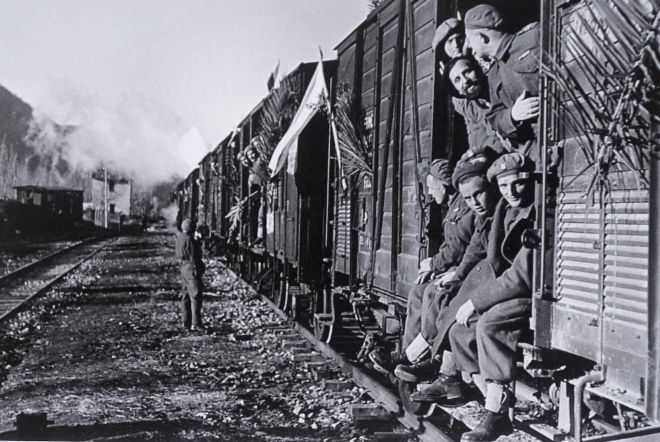
Even more importantly going against any idea that socialism was now raising its head for a fairer society.(one of the worst offenders was the Labour party and London transport. But people are left with memories of how they wanted things to be and not how they were.Much of the sixties were horrendous housing estates that were sabotaged by neo lib supposed left wing councils when they stopped vetting possible aspirants for homes . After this the whole idea floundered and is still with us today.

Peter Blake said: 'It was as though everything was being invented. It was only a little more than 10 years after the war, and everything was new - television was young, theatre was exciting, cinema was exciting. But workers slaved over Victorian wages and Victorian London was still pretty much all around. The swinging sixties were in the words of one worker, the swinging ponces.
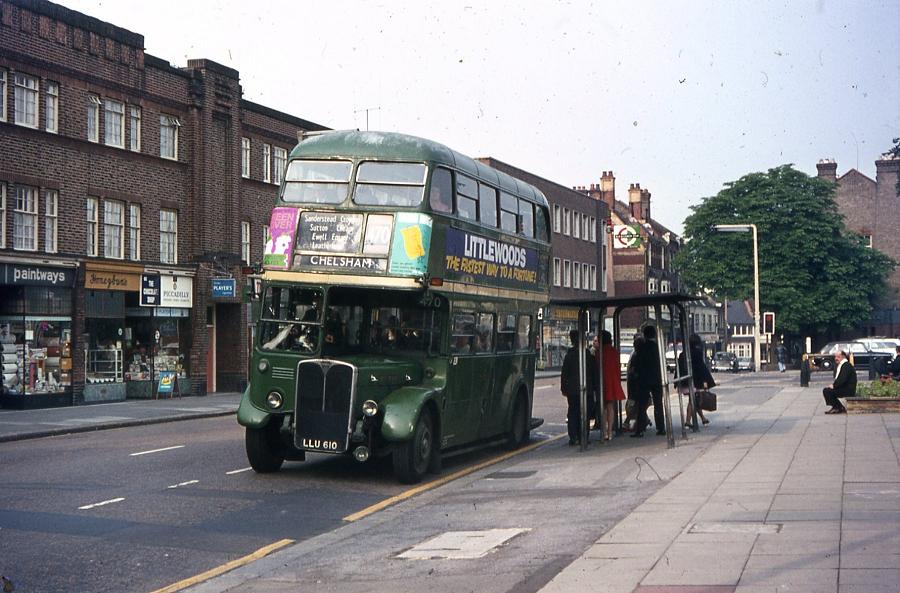 Cinema in reality wasn't great , there was an huge amount of dross especially as regards the angry young men type of films but some were fun and some were even realistic but hardly any. Not all camps were the same, writing had become interesting with new writers and art had tried to create new areas of research.One can understand that among the young that the old Edwardian dictate was beginning to dissolve. Capitalists would eventually find a new way of condemning the workers to perpetual ignorance but the sixties looked like their hold on things was beginning to fade.
Cinema in reality wasn't great , there was an huge amount of dross especially as regards the angry young men type of films but some were fun and some were even realistic but hardly any. Not all camps were the same, writing had become interesting with new writers and art had tried to create new areas of research.One can understand that among the young that the old Edwardian dictate was beginning to dissolve. Capitalists would eventually find a new way of condemning the workers to perpetual ignorance but the sixties looked like their hold on things was beginning to fade. In the film Alfie, stunning blonde actress Pauline Boty played one of Michael Caine's girlfriends. But within months, she would be dead and her family plunged into tragedy.Today, as cinema-goers flock to see a remake of the film - this time starring Jude Law
In the film Alfie, stunning blonde actress Pauline Boty played one of Michael Caine's girlfriends. But within months, she would be dead and her family plunged into tragedy.Today, as cinema-goers flock to see a remake of the film - this time starring Jude Law
as the serial womaniser - the movie will bring back nothing but bad memories for Pauline's family. "I've never been able to watch the original and it'll be hard to see the new one,"
 says Bridget, Pauline's sister-in-law. et before the film's London premiere, in March 1966, Pauline's world was beginning to fall apart. (above Jude Law who starred in the remake)
says Bridget, Pauline's sister-in-law. et before the film's London premiere, in March 1966, Pauline's world was beginning to fall apart. (above Jude Law who starred in the remake)
It was during one of her trips to Kent in 1965 that she broke some dramatic news to Bridget.

"She was sitting on the sofa and she looked at me and said: 'I'm pregnant.'

"I was overjoyed for her, although very surprised as she'd never spoken about wanting children.

"Then she said the doctors had found a lump on one of her breasts and that she had to go back to hospital for more tests.

"She must have known it was serious because she was very withdrawn and I was the first person she'd told.

"I tried to cheer her up, saying it was probably nothing, but that was the last time I saw her..."

Pauline soon learned that she was suffering from a rare form of leukaemia and doctors at the Royal Marsden Hospital, Surrey, presented her with a stark choice.

If she was to have a chance of surviving, she would have to undergo chemotherapy. This would mean aborting her baby, who would not survive the treatment. If we could select one person who epitomised that whole Swinging Sixties, art school, groovy London scene it would most likely be Pauline Boty.
Pauline boty was a woman who was not prepared to take a back seat and looked like she would be the spokesman for her age until she very sadly passed on so very young.It makes the things she created only the more remarkable.

Making the ultimate sacrifice, Pauline refused and the child, named Katy, was born on February 12, 1966.

"The biggest shame is that Pauline (below)gave up her life for Katy who just threw it all away." Her daughter killed herself more or less if not suicide with Heroin
.David Mellor, the art historian, first saw her in Pop Goes the Easel, Ken Russell's 1962 film for the BBC arts magazine Monitor, which followed four young pop artists (Boty, Blake, Derek Boshier and Peter Phillips) around London. Mellor remembers being 'thrilled by these people, their excitement, their life, their ordinariness', and spent years searching out Boty's pictures for his 'Sixties' exhibition at the Barbican. In his mind, she may be the great woman pop artist who never was.

Boty was born in 1938 and brought up, with three older brothers, in a 1930s semi ('normally termed 'desirable',' she told the Express later, 'I don't approve, of course, but I daren't say anything: Daddy would be upset'). Her mother, who was of Irish extraction, was weakened by a bout of tuberculosis when Boty was 12, but they lived a comfortable suburban life - family rows (her parents were protective and disapproved of her painting); sibling tension, holidays on the Norfolk Broadsro
 Boty attended Wallington County Girls School, where she won a scholarship to study stained glass at Wimbledon School of Art. Her tutor there, Charles Carey
Boty attended Wallington County Girls School, where she won a scholarship to study stained glass at Wimbledon School of Art. Her tutor there, Charles Carey remembers walking into the stained-glass room to find his students jiving to Buddy Holly and dressing up in each other's clothes. At the end of one term, he says, he found 20 individual shoes under the easels.
remembers walking into the stained-glass room to find his students jiving to Buddy Holly and dressing up in each other's clothes. At the end of one term, he says, he found 20 individual shoes under the easels.In 1959, Boty left Wimbledon, moved into central London and entered the Royal College of Art (one year ahead of Boshier, David Hockney and Alan Jones). It was here, on the cusp of the Sixties, that life took off. The writer and director Roger Smith, who met Boty when he came down from Oxford in 1960,
 together.' Blake, staring gloomily into a coffee cup in Chiswick, agrees. 'It was as though everything was being invented. It was only a little more than 10 years after the war, and everything was new - television was young, theatre was exciting, cinema was exciting. There were all the new immigrants(Blake leaves out the bitter truth on why a Labour government had started to recruit workers in the West Indies) and places like Portobello Road were springing up. It was vibrant, and to be there was marvellous.'
together.' Blake, staring gloomily into a coffee cup in Chiswick, agrees. 'It was as though everything was being invented. It was only a little more than 10 years after the war, and everything was new - television was young, theatre was exciting, cinema was exciting. There were all the new immigrants(Blake leaves out the bitter truth on why a Labour government had started to recruit workers in the West Indies) and places like Portobello Road were springing up. It was vibrant, and to be there was marvellous.' 
'It was the most insane time,' says Penny Massot. The image of Boty, who was there while it was happening and died before it stopped, must in people's minds be identified with this nostalgia. To a certain extent, the things she did and the nature of her personality crystallised that explosive period.
Boty was, to quote Derek Boshier, 'a great bringer-together of people'.
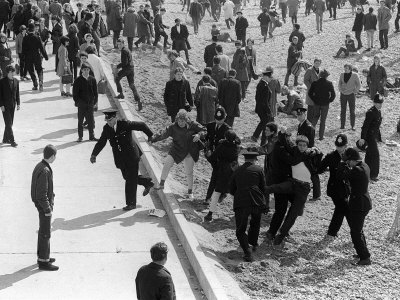 Wherever she lived, in a variety of flats in west London, she was surrounded by students, artists and eccentrics. London was a small world and most of it sat around her kitchen table.
Wherever she lived, in a variety of flats in west London, she was surrounded by students, artists and eccentrics. London was a small world and most of it sat around her kitchen table. At one time, in a flat in Holland Park, she had a black-painted loo and garden swings in the sitting-room. Before that, shen a house in
At one time, in a flat in Holland Park, she had a black-painted loo and garden swings in the sitting-room. Before that, shen a house in  lived in Shepherd's Bush, in which Peter Blake and Derek Boshier shared a studio. The designer Celia Birtwell lived in the room next door,
lived in Shepherd's Bush, in which Peter Blake and Derek Boshier shared a studio. The designer Celia Birtwell lived in the room next door, Ossie Clark was always dropping by and visitors remember parties and champagne breakfasts and heated discussions. Christopher Logue met her there for the first time. She was in the garden, eating strawberries.
Ossie Clark was always dropping by and visitors remember parties and champagne breakfasts and heated discussions. Christopher Logue met her there for the first time. She was in the garden, eating strawberries. 
Boty backcombed her hair and pooled clothes with her friends ('She fancied an orange linen Swedish type coat of mine, which I swapped for a pale bomber jacket,' remembers a flatmate).
 She spent Saturday nights in Soho at The Establishment; she twisted on Ready Steady Go ('they knew me and Pauline at the door,' says Boshier); she smoked pot, and occasionally took Benzedrine, though she preferred Purple Hearts. (After she died, Clive Goodwin gave evidence to the 1969 Wootton Committee on cannabis - he told how marijuana had helped the pain when she was ill.)
She spent Saturday nights in Soho at The Establishment; she twisted on Ready Steady Go ('they knew me and Pauline at the door,' says Boshier); she smoked pot, and occasionally took Benzedrine, though she preferred Purple Hearts. (After she died, Clive Goodwin gave evidence to the 1969 Wootton Committee on cannabis - he told how marijuana had helped the pain when she was ill.) 
But she was also working hard. Shortly after leaving the Royal College of Art in 1961, she and Jane Percival, a fellow student and former flatmate, taught for a couple of terms in the mural department at Hammersmith School of Art. The rest of the time they painted.
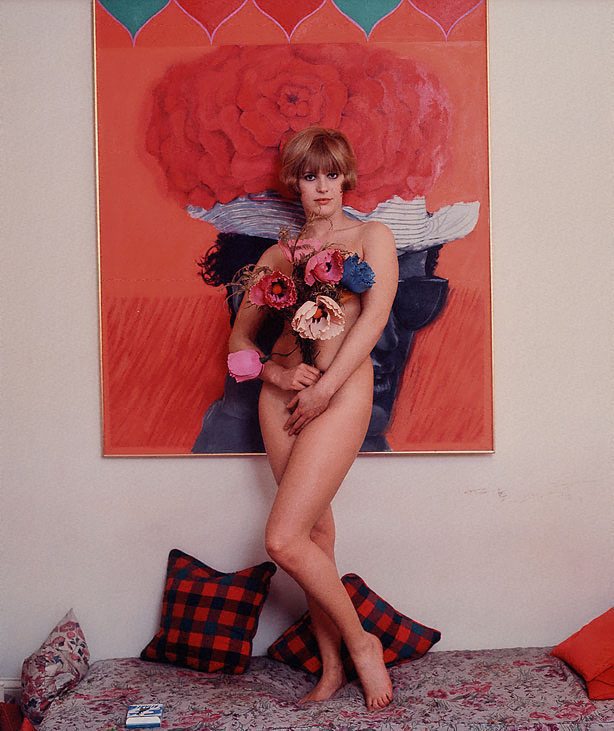
Boty featured in what Charles Carey believes was the first ever pop art exhibition, 'Blake, Boty, Porter, Reeve', at the AIA Gallery in 1961. In 1962 her work was included in 'New Approaches to the Figure' at the Arthur Jeffress Gallery, and in 1963 she contributed to 'Pop Art' at the Midland Group Gallery in Nottingham. Shortly after this, she was approached by the dealer Garbowski (now dead), who put on her first solo exhibition in the gallery he ran at the back of his chemist shop in Sloane Avenue. Interest in her work began to grow. .

But, like the Sixties themselves, Boty's life swung engagingly between work, fun and politics. She was secretary of Anti-Ugly Action, a student pressure group which, between 1959 and 1961, marched on the new Kensington Library, demonstrated at Caltex House, scattered rose petals on the coffin of British Architecture outside the new Barclays Bank head office.
 The press reports on the demonstrations tended to focus their attention on Boty, bemused by this beautiful, middle-class activist. 'Of all things she (arrow to photograph) is secretary of the Anti-Uglies]' exclaimed the Daily Express. Boty's quotations sound wonderfully nave now: 'I think the Air Ministry building is a real stinker, and the Farmers' Union, the Bank of England and the Financial Times as
The press reports on the demonstrations tended to focus their attention on Boty, bemused by this beautiful, middle-class activist. 'Of all things she (arrow to photograph) is secretary of the Anti-Uglies]' exclaimed the Daily Express. Boty's quotations sound wonderfully nave now: 'I think the Air Ministry building is a real stinker, and the Farmers' Union, the Bank of England and the Financial Times as  runners-up]' But her engagement with the cause was typical of her fervour for argument. She knew her own mind and wasn't afraid to say it. Christopher Logue saw her some time later on a televised chat- show with A J P Taylor:
runners-up]' But her engagement with the cause was typical of her fervour for argument. She knew her own mind and wasn't afraid to say it. Christopher Logue saw her some time later on a televised chat- show with A J P Taylor:  'Adolf Hitler's name came up and Taylor described him as a 'great man' in terms of history. Pauline (I think not-ed) would have none of it: 'The size of his deeds no more make him great than their nature makes him good,' she said - or words to that effect.. Taylor paused too.(Taylor one of the very few socialists in the UK and in Europe had been the man who had kept one of our greatest poets afloat that man being Dylan Thomas and he may not have been very amused by this remark as regards his mind.)
'Adolf Hitler's name came up and Taylor described him as a 'great man' in terms of history. Pauline (I think not-ed) would have none of it: 'The size of his deeds no more make him great than their nature makes him good,' she said - or words to that effect.. Taylor paused too.(Taylor one of the very few socialists in the UK and in Europe had been the man who had kept one of our greatest poets afloat that man being Dylan Thomas and he may not have been very amused by this remark as regards his mind.)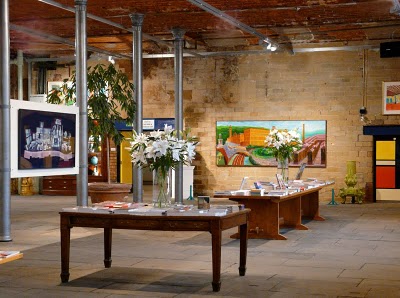
A glitzier side of Boty was brought out by her affair, which began at the end of her student years, with the producer and director Philip Saville. He met her at a New Year's Eve ball at the Royal College of Art: 'I
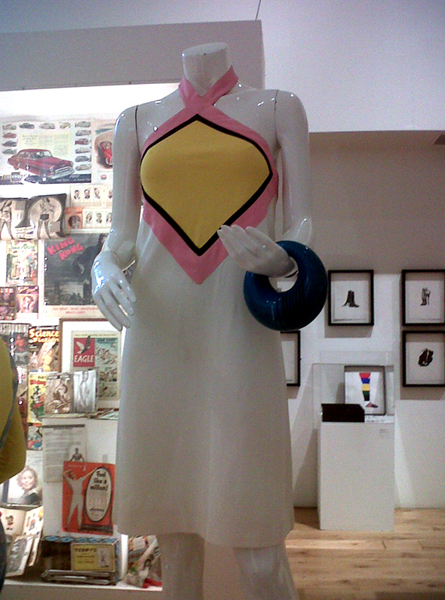 saw this startlingly beautiful woman and powered my way through about 15 blokes to talk to her.' Like her husband later, he (photo of saville below)encouraged her to act, a move that alienated some of her art school contemporaries ('there was a slight schism around that time,' says Boshier).
saw this startlingly beautiful woman and powered my way through about 15 blokes to talk to her.' Like her husband later, he (photo of saville below)encouraged her to act, a move that alienated some of her art school contemporaries ('there was a slight schism around that time,' says Boshier). She appeared, with a modicum of success, in Frank Hilton's Day of the Prince at the Royal Court in 1962, in North by Northwest, a play Saville directed for ABC (the
She appeared, with a modicum of success, in Frank Hilton's Day of the Prince at the Royal Court in 1962, in North by Northwest, a play Saville directed for ABC (the 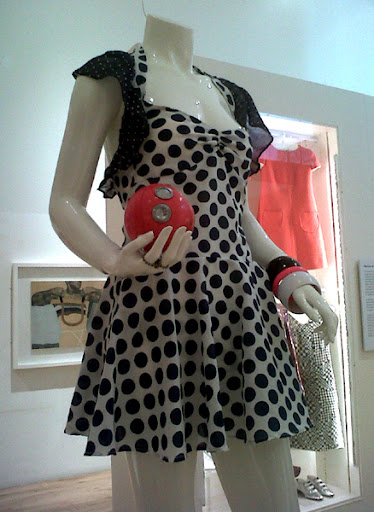 precursor to Thames), and screen-tested for various films, including John Schlesinger's Darling. It was between her and Julie Christie for the part of Diana; Julie Christie was given it. Blake, loyally, thinks Boty would have been much better.
precursor to Thames), and screen-tested for various films, including John Schlesinger's Darling. It was between her and Julie Christie for the part of Diana; Julie Christie was given it. Blake, loyally, thinks Boty would have been much better.
It is considered one of Schlesinger's best films and an insightful satire of mid-sixties British culture. Darling tells the story of a bored young married woman named Diana Scott (Julie Christie)
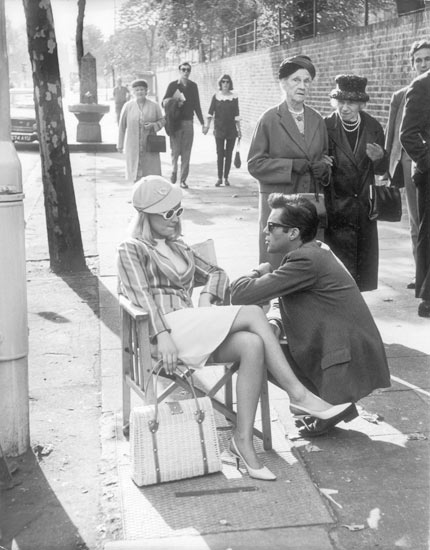 who drifts up the social and economic ladders of modern society without really knowing what she wants. Initially she draws the attention of a television journalist (Dirk Bogarde) and they both leave their spouses to begin an affair. After growing increasingly bored with this relationship, she begins working as a television and print model and minor actress, this work bringing her into the orbit of a cynical ad executive (Laurence Harvey). Eventually, both relationships fall apart, but while shooting a television commercial in Italy, she meets an aging, widowed Italian prince (Jose Luis de Villalonga)
who drifts up the social and economic ladders of modern society without really knowing what she wants. Initially she draws the attention of a television journalist (Dirk Bogarde) and they both leave their spouses to begin an affair. After growing increasingly bored with this relationship, she begins working as a television and print model and minor actress, this work bringing her into the orbit of a cynical ad executive (Laurence Harvey). Eventually, both relationships fall apart, but while shooting a television commercial in Italy, she meets an aging, widowed Italian prince (Jose Luis de Villalonga)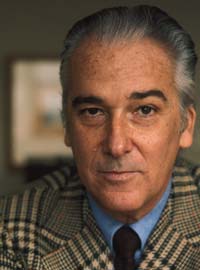 with several children and marries him. The marriage proves unsatisfactory, but she eventually discovers that there is no way out.It has to be said that for the first half "
with several children and marries him. The marriage proves unsatisfactory, but she eventually discovers that there is no way out.It has to be said that for the first half " Darling" seems to meander along at such an odd and slow pace that it is easy to walk away from. It just doesn't flow and whilst it is easy to follow as we can easily pick up on the fact that Diana is bored with her life and so seeks excitement through having affairs it struggles to keep your attention.
Darling" seems to meander along at such an odd and slow pace that it is easy to walk away from. It just doesn't flow and whilst it is easy to follow as we can easily pick up on the fact that Diana is bored with her life and so seeks excitement through having affairs it struggles to keep your attention.  It does pick up pace and as we watch Diana climb the social ladder via various relationships it also gets a little interesting but in a way it doesn't seem to be going anywhere,
It does pick up pace and as we watch Diana climb the social ladder via various relationships it also gets a little interesting but in a way it doesn't seem to be going anywhere, a fact high lighted by the less than sensational ending.But the thing about "Darling" is that it is a movie which is about the 60s, the sexual liberation, the weird parties and so on and so fourth. And that is a problem because unless you can appreciate the 60s having lived through it
a fact high lighted by the less than sensational ending.But the thing about "Darling" is that it is a movie which is about the 60s, the sexual liberation, the weird parties and so on and so fourth. And that is a problem because unless you can appreciate the 60s having lived through it  "Darling" wil lmaybe end up rather dull because its not a great film that transcends its time. It is very much a movie which is a document of the 60's but doesn't show us the real 60's, much is left out and we have an idea that the sixties was just darling and Julie Christie, .Despite my struggle to be entertained by the storyline I have to say I was gripped by Julie Christie because she is stunning .
"Darling" wil lmaybe end up rather dull because its not a great film that transcends its time. It is very much a movie which is a document of the 60's but doesn't show us the real 60's, much is left out and we have an idea that the sixties was just darling and Julie Christie, .Despite my struggle to be entertained by the storyline I have to say I was gripped by Julie Christie because she is stunning .  What impresses about Christie's performance is that she gets across the dissatisfaction with life, her struggle with boredom and normality causing her to seek excitement.
What impresses about Christie's performance is that she gets across the dissatisfaction with life, her struggle with boredom and normality causing her to seek excitement. But at the same time you also get the sense of emptiness that Diana has, that every time she gets her fix of excitement via having an affair she then hits a huge low of normality.
But at the same time you also get the sense of emptiness that Diana has, that every time she gets her fix of excitement via having an affair she then hits a huge low of normality.  . The trouble is that "Darling" is a movie about certain people in the 60's , people that the majority wouldn't have known back then but it is a film about people who personified one part of that time.
. The trouble is that "Darling" is a movie about certain people in the 60's , people that the majority wouldn't have known back then but it is a film about people who personified one part of that time.  its almost meandering first half it all seems to be going nowhere. "Darling", in fact, is a movie for those who lived through other periods as it is faithful to its subject matter although not a historical summing up even in a small part of that important period..
its almost meandering first half it all seems to be going nowhere. "Darling", in fact, is a movie for those who lived through other periods as it is faithful to its subject matter although not a historical summing up even in a small part of that important period.. Darling is not about sixties people, its more about fifties pe0ople finding themselves caught up in swinging london apart from christie. The sixties neo-lib film maker wanted to be thought of as socialistic as opposed to socialist in the Marxist terminology,thus the working-class are supposedly to the fore and ushered into front seats in the 60s vogue for social realist/ kitchen sink dramas like Look Back in Anger (1956) and Saturday Night and Sunday Morning (1960) distinguished by their decidedly male-centric point of view and the middle class bourgeois view of the workers.But this view is much more evident in the fact that it is the director who comes across as bourgeois in the total lack of understanding for the workers . Nearly all the sixties new wave cinema were reeking of middle class would be Red Guards lack of real understanding as regards the ordinary worker. This point of view is as obvious today as it was then, the fact is the sixties film maker, the so called new wave director was as ill-informed of socialism as they are today. Of course this feeling may even be unconscious on the part of the directors but its plainly present.Darling was a better film than most because it never had pretensions and was what it was.It doesn't touch that much on Pauline boty's world as regards her part of the 60's but it does show as some of the cross line reasons of the times.Boty was said to be the subject matter of this film but Darling was far removed from Boty's life.
Darling is not about sixties people, its more about fifties pe0ople finding themselves caught up in swinging london apart from christie. The sixties neo-lib film maker wanted to be thought of as socialistic as opposed to socialist in the Marxist terminology,thus the working-class are supposedly to the fore and ushered into front seats in the 60s vogue for social realist/ kitchen sink dramas like Look Back in Anger (1956) and Saturday Night and Sunday Morning (1960) distinguished by their decidedly male-centric point of view and the middle class bourgeois view of the workers.But this view is much more evident in the fact that it is the director who comes across as bourgeois in the total lack of understanding for the workers . Nearly all the sixties new wave cinema were reeking of middle class would be Red Guards lack of real understanding as regards the ordinary worker. This point of view is as obvious today as it was then, the fact is the sixties film maker, the so called new wave director was as ill-informed of socialism as they are today. Of course this feeling may even be unconscious on the part of the directors but its plainly present.Darling was a better film than most because it never had pretensions and was what it was.It doesn't touch that much on Pauline boty's world as regards her part of the 60's but it does show as some of the cross line reasons of the times.Boty was said to be the subject matter of this film but Darling was far removed from Boty's life.The “Angry Young Men” label associated with these brit new wave films is in most cases as likely a plot synopsis as genre signifier.
The males are a restless and tugging at the constraints of the British class system. The women, however, are portrayed as either domestic drudges who stand as obstacles to the hero’s independence, or sexually-available conquests whose troublesome biology (they would get pregnant) brands them as anchors to a life of lower-class squalor.
This is interesting as it shows us that the supposed socialism had not yet reached down to the other half of human beings.Women .And shows us that supposed left wing film makers had to have their ideas made up for them later. Most became right wing establishment figures in their later years while some remained simply odd in the political spectrum.
The passive roles played by Mary Ure and Claire Bloom in Look Back in Anger are typical of how women were portrayed. There were exceptions, Simone Signoret’s worldly older-
 woman in Room at the Top (1959) and Rachel Roberts’ in This Sporting Life (1963);
woman in Room at the Top (1959) and Rachel Roberts’ in This Sporting Life (1963);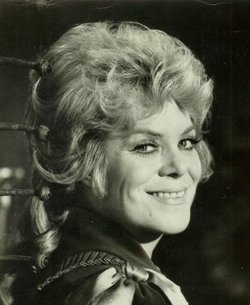 Rita Tushingham in Tony Richardson’s A Taste of Honey (1961)
Rita Tushingham in Tony Richardson’s A Taste of Honey (1961) who provided a change-of-pace . Tushingham’s Manchester teen was the voice of feminism in its true form within the genre .One wonders how good Pauline Boty would have been in many of
who provided a change-of-pace . Tushingham’s Manchester teen was the voice of feminism in its true form within the genre .One wonders how good Pauline Boty would have been in many of these parts because she lived upfront feministic ideals .
these parts because she lived upfront feministic ideals .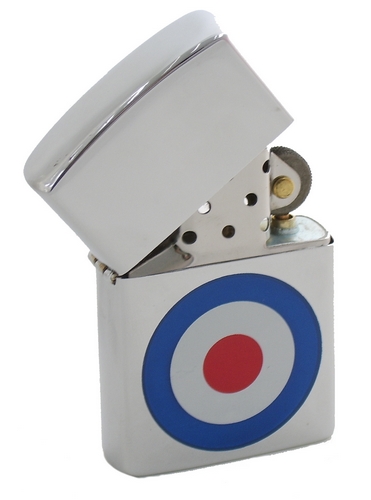 Pauline Boty in the British New Wave may have been a turning point in the evolution of women in British cinema. The mid-60s reversal of England’s post-war economic decline signaled a gradual abandonment of tales of kitchen-sink-class oppression. Northern England versus the mod scene of London. Dullards v Coolness.
Pauline Boty in the British New Wave may have been a turning point in the evolution of women in British cinema. The mid-60s reversal of England’s post-war economic decline signaled a gradual abandonment of tales of kitchen-sink-class oppression. Northern England versus the mod scene of London. Dullards v Coolness. The UK thought it was a place where social satire, consumerism, and youth-culture took the place of traditional class rebellion.What it really was was a place in love with its "look at me" persona.It never got beyond a facade although the intellectuals of the far left tried to create a new society as regards Marxism. It failed because people really wanted the new consumerism.
The UK thought it was a place where social satire, consumerism, and youth-culture took the place of traditional class rebellion.What it really was was a place in love with its "look at me" persona.It never got beyond a facade although the intellectuals of the far left tried to create a new society as regards Marxism. It failed because people really wanted the new consumerism.
John Schlesinger’s Darling is a darkly comic, corrosive criticism of the swinging London jet set, a superficial heroine. Julie Christie’s Diana Scott is a London model possessing looks, self-confidence, charm, vivacity, ambition… in short, she is the sixties . She’s everyone’s darling and her beauty is all, there is nothing beneath . As the film ends, Diana, who is always looking out for herself, is left with a scene that they called the sixties but in reality was just a period of distinct time that then lost its uniqueness and merged with another , the Seventies.
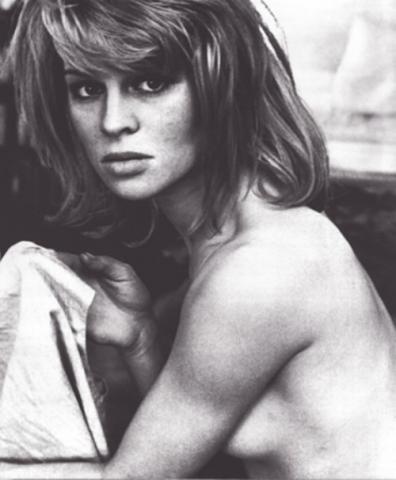
Darling lampoons this culture we have fashioned for ourselves that sells people ideas of lifestyles rather than encourages us to live.  The sixties mod London was chiefly beneficial to the shopkeepers, stores, and businesses, it was about fashion and new style more than true socialism, Darling makes this clear . But did Schlesinger agree on the star-making performance of Julie Christie;this is what he said "She was very striking. When we came to cast Billy Liar, there we were in Joe Janni's office, and there was a magazine which Julie was on the cover of. I pointed at it and said 'Someone like her,' not recognizing her. She came in and tested, twice, and we turned her down. I didn't think she was "earth mother" enough. The other girl who we cast got ill during the first week of shooting and had to drop out.(I think here the director was remembering Darling and not Liar as it seems that the other girl was Boty and if she had not been considered for Liar then this film must have been Darling-ed) So we went back to the tests and saw Julie, and thought 'My God, we're mad! Why didn't we cast Julie?' So we put her in and that's how it happened.The genesis of that was a conversation we had with a journalist called Godfrey Winn, who played the man in Billy Liar who played all the records on Housewives' Choice. He was quite a character. He told me a story about a syndicate of show biz people who'd rented a flat for a kind of call girl to live in, to whom they all had access, and how she eventually threw herself off the balcony, in Park Lane. We thought that was an interesting premise, but we veered very far away from it. Freddie Raphael came on board to write his script and it was total fantasy. Joe Janni said, 'I know a girl who I'd like you to spend time with and follow around, who's the perfect type for this movie.' So we spent a lot of time with this girl, and finally a script based to a certain extent on her life, was produced by Freddie, which was much closer to the mark. And we went ahead and made it. "But who was this girl , was it Boty?
The sixties mod London was chiefly beneficial to the shopkeepers, stores, and businesses, it was about fashion and new style more than true socialism, Darling makes this clear . But did Schlesinger agree on the star-making performance of Julie Christie;this is what he said "She was very striking. When we came to cast Billy Liar, there we were in Joe Janni's office, and there was a magazine which Julie was on the cover of. I pointed at it and said 'Someone like her,' not recognizing her. She came in and tested, twice, and we turned her down. I didn't think she was "earth mother" enough. The other girl who we cast got ill during the first week of shooting and had to drop out.(I think here the director was remembering Darling and not Liar as it seems that the other girl was Boty and if she had not been considered for Liar then this film must have been Darling-ed) So we went back to the tests and saw Julie, and thought 'My God, we're mad! Why didn't we cast Julie?' So we put her in and that's how it happened.The genesis of that was a conversation we had with a journalist called Godfrey Winn, who played the man in Billy Liar who played all the records on Housewives' Choice. He was quite a character. He told me a story about a syndicate of show biz people who'd rented a flat for a kind of call girl to live in, to whom they all had access, and how she eventually threw herself off the balcony, in Park Lane. We thought that was an interesting premise, but we veered very far away from it. Freddie Raphael came on board to write his script and it was total fantasy. Joe Janni said, 'I know a girl who I'd like you to spend time with and follow around, who's the perfect type for this movie.' So we spent a lot of time with this girl, and finally a script based to a certain extent on her life, was produced by Freddie, which was much closer to the mark. And we went ahead and made it. "But who was this girl , was it Boty?
 The sixties mod London was chiefly beneficial to the shopkeepers, stores, and businesses, it was about fashion and new style more than true socialism, Darling makes this clear . But did Schlesinger agree on the star-making performance of Julie Christie;this is what he said "She was very striking. When we came to cast Billy Liar, there we were in Joe Janni's office, and there was a magazine which Julie was on the cover of. I pointed at it and said 'Someone like her,' not recognizing her. She came in and tested, twice, and we turned her down. I didn't think she was "earth mother" enough. The other girl who we cast got ill during the first week of shooting and had to drop out.(I think here the director was remembering Darling and not Liar as it seems that the other girl was Boty and if she had not been considered for Liar then this film must have been Darling-ed) So we went back to the tests and saw Julie, and thought 'My God, we're mad! Why didn't we cast Julie?' So we put her in and that's how it happened.The genesis of that was a conversation we had with a journalist called Godfrey Winn, who played the man in Billy Liar who played all the records on Housewives' Choice. He was quite a character. He told me a story about a syndicate of show biz people who'd rented a flat for a kind of call girl to live in, to whom they all had access, and how she eventually threw herself off the balcony, in Park Lane. We thought that was an interesting premise, but we veered very far away from it. Freddie Raphael came on board to write his script and it was total fantasy. Joe Janni said, 'I know a girl who I'd like you to spend time with and follow around, who's the perfect type for this movie.' So we spent a lot of time with this girl, and finally a script based to a certain extent on her life, was produced by Freddie, which was much closer to the mark. And we went ahead and made it. "But who was this girl , was it Boty?
The sixties mod London was chiefly beneficial to the shopkeepers, stores, and businesses, it was about fashion and new style more than true socialism, Darling makes this clear . But did Schlesinger agree on the star-making performance of Julie Christie;this is what he said "She was very striking. When we came to cast Billy Liar, there we were in Joe Janni's office, and there was a magazine which Julie was on the cover of. I pointed at it and said 'Someone like her,' not recognizing her. She came in and tested, twice, and we turned her down. I didn't think she was "earth mother" enough. The other girl who we cast got ill during the first week of shooting and had to drop out.(I think here the director was remembering Darling and not Liar as it seems that the other girl was Boty and if she had not been considered for Liar then this film must have been Darling-ed) So we went back to the tests and saw Julie, and thought 'My God, we're mad! Why didn't we cast Julie?' So we put her in and that's how it happened.The genesis of that was a conversation we had with a journalist called Godfrey Winn, who played the man in Billy Liar who played all the records on Housewives' Choice. He was quite a character. He told me a story about a syndicate of show biz people who'd rented a flat for a kind of call girl to live in, to whom they all had access, and how she eventually threw herself off the balcony, in Park Lane. We thought that was an interesting premise, but we veered very far away from it. Freddie Raphael came on board to write his script and it was total fantasy. Joe Janni said, 'I know a girl who I'd like you to spend time with and follow around, who's the perfect type for this movie.' So we spent a lot of time with this girl, and finally a script based to a certain extent on her life, was produced by Freddie, which was much closer to the mark. And we went ahead and made it. "But who was this girl , was it Boty?
. Boty may well have been better though for one simple reason and that might be that she had a more interesting face if less perfect than Christie.. Yet Christie exhibits that appealingly straightforward quality that would characterize her entire career. . It may be interesting when a smart actor plays a not-very-bright character or is Christie simply playing herself.. In films with leads as gorgeous as Julie Christie, it not uncommon for us to concentrate unconsciously on beauty.The film is sympathetic to homosexuals, and Bogarde may have insisted on it despite the fact that Bogarde invested considerable energy (throughout several autobiographies) in portraying himself publicly as a heterosexual. John Schlesinger was obviously in love with Christie as he had taken on the role of a kind of guardian by sending her long letters warding her off warren beatty, if thats not undisclosed love what is? THE STUFF OF DREAMS:
THE STUFF OF DREAMS:
 THE STUFF OF DREAMS:
THE STUFF OF DREAMS:I first saw Darling by chance on telly and ignored it as a boring slightly stupid sixties film. In 1965 one may have found it much more interesting. Darling poked fun at TV commercials, fame whores, liberal hypocrites, self-righteous homophobes, promiscuity for profit, the myth of “having it all”, etc but they are are still a prominent part of our pop-culture when we consider the idiotic amount of Simons around doiung remakes of big brother and the like, the point is that today there is not the intellectual seriousness or quality to produce a film like Darling to denounce the morass of Squallor within our society as we go towards 2013. Maybe this is one merit of the film.
Darling is the film that made stars of both Julie Christie and John Schlesinger. Schlesinger's next film would be his last with Christie; the big-budget adaptation of the Thomas Hardy novel, Far From the Madding Crowd (1967).I remember this in much the same way as Darling, pretty forgettable with forgettable performances although it was superb photography and settings

. Few actresses get to become iconic stars and Christie became one for Darling. There are many remarkable actresses around, but Christie is not one of them in my opinion, Shes incredible as regards her beauty in those early films but the thing I remember most is her feeling of boredom that she seemed to express . But maybe Im wrong as most think she was great. I'll rewatch her films more intently because its easy to make unfounded affirmations positive or negative.
There are many remarkable actresses around, but Christie is not one of them in my opinion, Shes incredible as regards her beauty in those early films but the thing I remember most is her feeling of boredom that she seemed to express . But maybe Im wrong as most think she was great. I'll rewatch her films more intently because its easy to make unfounded affirmations positive or negative.
 There are many remarkable actresses around, but Christie is not one of them in my opinion, Shes incredible as regards her beauty in those early films but the thing I remember most is her feeling of boredom that she seemed to express . But maybe Im wrong as most think she was great. I'll rewatch her films more intently because its easy to make unfounded affirmations positive or negative.
There are many remarkable actresses around, but Christie is not one of them in my opinion, Shes incredible as regards her beauty in those early films but the thing I remember most is her feeling of boredom that she seemed to express . But maybe Im wrong as most think she was great. I'll rewatch her films more intently because its easy to make unfounded affirmations positive or negative.
During this period Jane Percival held a supper party to which Pauline and Philip were invited. 'They turned up with some musician in tow,' Percival recalls, 'and Pauline said, 'Look, I'm terribly sorry, Jane, we can't come in, we've got to go to a reception, but will you look after this guy for the evening? He's over to do a play for Philip.' The play was Evan Jones's The Madhouse on Castle Street, which Saville produced for the BBC. The musician was Bob Dylan. He sat in the corner and played 'Blowin' in the Wind'.
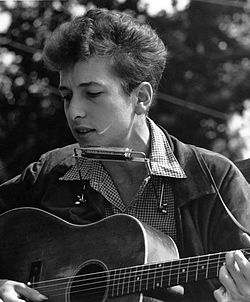
Memories like that only add to the Boty mythology. So, too, does the way in which she finally extricated herself from the still-married Saville. 'We were walking down the street,' Saville says, 'and I saw Ken Tynan, who I knew, and his friend Clive Goodwin was with him. I could see Clive was desperate to be introduced - his eyes were popping out of his head. Ten days later, I received a telegram which read: 'By the time you read this,

I will be married to Clive Goodwin. Please forgive me.' '
The marriage, by all accounts, transformed Goodwin. 'Before he met her,' says Roger Smith, 'he was a very quiet New Statesman-in- the-back-pocket sort of man, very alone. Suddenly, when they got together, their house became a centre.' It seemed to be a happy marriage. Massot says: 'If you'd looked at them you'd never have thought they were suited. He was straight and conventional and she was wacky, never quite knew whether she should be with Clive, you know . . . But I think they were dreamy together.' In an interview with Nell Dunn for her book Talking to Women (1965), Boty says she married Goodwin because he made her feel secure and because 'he was the first man who made me laugh sort of quite sincerely over the telephone'.

Boty was always open; she had an air of sexual liberation that is strongly associated with the later Sixties. Charles Carey recalls a younger student going up to her in the canteen at Wimbledon and asking her why she wore so much red lipstick: ' 'All the better to kisssss you with,' she said, and chased him out of the room.' She sunbathed topless in Ibiza; she posed naked in front of her picture of Johnny Hallyday for the photographer Lewis Morley. In a painting called 5,4,3,2,1, the words 'OH FOR A FU' are scrawled across the corner. And in the Nell Dunn interview, she spoke frankly about her 'ugly cunt'. 'When I was very little, surrounded by my brothers and everything
 . . . I wanted to be a boy. I used to pull - you know that sort of skin you have - I used to pull it, you see, and I slightly deformed it to make it sort of longer and so I used to spend all my time when I went to bed with someone thinking 'they'll find out'.'
. . . I wanted to be a boy. I used to pull - you know that sort of skin you have - I used to pull it, you see, and I slightly deformed it to make it sort of longer and so I used to spend all my time when I went to bed with someone thinking 'they'll find out'.'
NELL DUNN had asked to interview Boty because 'I was interested in her as a woman who took being a painter very seriously'. It was a seriousness not fully shared by those around her. Jane Percival, a close contemporary, found it hard being a working woman artist during that period. 'It was a funny time actually,' she says. 'Women painters like myself felt very alienated, the full feminist movement hadn't come in and we worked in isolated pools, mostly of depression.'

Caroline Coon believes Boty was distracted from painting by the men around her: 'Most of these men weren't going to encourage her that much because of her beauty, they were all telling her, 'You must be in the movies.' They wanted her to be the beautiful Muse, to eroticise her body and to ignore her painting.'

It is certainly noticeable that many who treasure Boty's memory are quite casual about her work. Peter Blake had one of her collages, but lent it to somebody.
 Michael White always meant to buy one, but didn't. Philip Saville did, but later sent it back. And when Saville talks about her work, he does so in relation to cooking: 'I used to have to tell her to scrub her nails because they always smelt of turpentine. 'One day' I'd say, 'you'll put turpentine in the salad dressing instead of vinegar.' '
Michael White always meant to buy one, but didn't. Philip Saville did, but later sent it back. And when Saville talks about her work, he does so in relation to cooking: 'I used to have to tell her to scrub her nails because they always smelt of turpentine. 'One day' I'd say, 'you'll put turpentine in the salad dressing instead of vinegar.' ' 
All of this really shows us that few men valued Boty's art and didn't know if it was any good at all, the question being that are these so called judges of art worth listening to ever.A peek into that sort of sneaky sexual attitude is provided by Russell's film, Pop Goes the Easel. Here is this documentary about four pop artists, but while the three young men are given the chance, individually, to talk about their work, Boty is provided with a weird, melodramatic dream sequence (in which she is chased down a corridor by a woman in a wheelchair) and the chance to serve coffee to the others. The main discussion of her work - collages in this instance - takes the form of a trivial spot- the-source game between her and Blake. 'There's Brendan Behan in a bottle . . . That's Somerset Maugham . . . those are specially roasted coffee beans from Elle'

It's a reminder that when the new RCA building was custom-designed in 1962, the planners didn't provide women's washrooms for the senior common room. Women artists weren't loudly excluded, but they were quietly discouraged. 'Imagine going through art school,' says Caroline Coon, 'and being told
 that the only woman artist of significance was Angelica Kauffmann? And she'd be mentioned with this sort of sneer.'
that the only woman artist of significance was Angelica Kauffmann? And she'd be mentioned with this sort of sneer.' 
And what about Boty? Did her work deserve recognition? Would the panoply of pop art have been different had she lived? What we have to go on is largely the output of someone who was still learning, but she was certainly doing interesting things. Coon, who was given Boty's paints by Goodwin, was struck by the colours of herpalette: 'Cobalt Violet and Lemon Deep Yellow. If, like me, you went to pre-diploma in Northampton with a very classical training, where you were only allowed a palette of four colours including Burnt Sienna, coming across these vibrant colours was quite startling.'
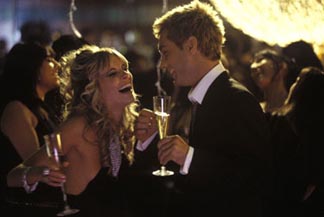
With those colours Boty made big, loud images: 'A generous, extrovert use of talent combined with a Gothic delicacy,' says Coon. Mellor believes her originality lies in her painted collages - 'that way of integrating ideas from collage while trying to stay with figurative painting'. Many of her pictures are brightly coloured scrapbooks of public and pop figures in ironic juxtaposition - Jean-Paul Belmondo,

Boty was also experimenting with images of women - 'using women,' says Blake, 'in a way women hadn't used women before'.(But as said Blake just lent one of her paintings to a mate, would he have done that with a Van gogh) It's a Man's World I and II is a diptych: I a jigsaw of male figures against an 18th-century landscape; a pin-up swirl of naked female flesh. In the unfinished piece, Tom's Dream, she was in the process of painting a woman, with pink painted nails,
 pulling a candy-floss chiffon nightie over her head; the shape of her crossed, upraised arms against the window frame behind her makes her look as though she were on a crucifix. 'It was a new voice,' says Mellor, 'a new way of imagining. They're pictures by someone wrestling with her own sexuality. It's that that makes them so extraordinary. 'Who's to say how good she might have been? It reminds me of that Norman Mailer essay. Two nights after Kennedy was shot, someone at a party said to him: 'The terrible thing is he was a great President.' But Mailer said: 'No. The terrible thing is we'll never know.'We do know in my opinion that Boty would have been a great artist because she already was and Kennedy would not have been as regards his involvement in many underhand things like the Bay of Pigs .
pulling a candy-floss chiffon nightie over her head; the shape of her crossed, upraised arms against the window frame behind her makes her look as though she were on a crucifix. 'It was a new voice,' says Mellor, 'a new way of imagining. They're pictures by someone wrestling with her own sexuality. It's that that makes them so extraordinary. 'Who's to say how good she might have been? It reminds me of that Norman Mailer essay. Two nights after Kennedy was shot, someone at a party said to him: 'The terrible thing is he was a great President.' But Mailer said: 'No. The terrible thing is we'll never know.'We do know in my opinion that Boty would have been a great artist because she already was and Kennedy would not have been as regards his involvement in many underhand things like the Bay of Pigs .
Her illness took hold as her pregnancy progressed, but it wasn't until after the baby was born in early 1966 that she became very ill. She had managed to look after the child to begin with - Nell Dunn remembers the baby in a basket at the end of the bed - but in her last dreadful months, her parents took over as she was shifted constantly between her house - a vast flat in the Cromwell Road - and the Royal Marsden. She became increasingly frail and was often in great pain. Despite this, many of her friends remained unaware of the seriousness of her illness until it was too late.

'It was almost as if they covered it up,' says a fellow student, Geoffrey Reeve, 'as if the less they admitted it to themselves, the happier she was.' The cancer was always hopeless, but a close friend, Natalie Gibson, remembers huge stacks of medical books in the bedroom and talk that the illness might take 10 years off her life. Others remember her despair. Massot, who visited every day, says: 'At one point she asked me to bring her some pills, because she couldn't stand it any longer. But I told Clive and he said no.'
Even in these last dreadful months, though, Boty continued to spar with life, spirited even under physical siege.
'What shall I bring?' asked Jane Percival, paralysed by a sense of inadequacy. 'Bring that delicious cheese-cake,' said Boty, even though she was too ill to eat it. She asked Natalie Gibson to bring veal and ham pie; others smuggled in 'great big joints'.

Roger Smith remembers her exasperation at his diffidence. 'She lost her temper; 'For fuck's sake, tell me what you've been doing,' she shouted.'
Another time, painfully thin, she laughed and told him what a change it was to be slim: 'It was typical of her, still managing to find something new in the experience,' he says. The last time Jane Percival saw her, she was propped up in bed, which they'd brought down to the sitting-room, with a drawing-board on her knee, doing a sketch of the Rolling Stones.

A lot of people were in love with Pauline Boty. A lot remember her with fondness and nostalgia. She probably had many irritating habits, but they have been ironed out by the intervening years. She was an interesting artist, who led a legendary sort of life and died a tragic death. Her only fault, says Peter Blake, 'was that she didn't love me back.'

Pauline was put in her place from the very beginning. She was the youngest of four. She and her mother were the only girls in the home. Her stern father made sure she was well aware of her gender. He even disapproved of Pauline attending the Wimbledon School of Art

She lived for only a few weeks after the birth of her daughter. Her friends were devastated; many are muddled even now as to the nature of her illness. The death of a young, talented person is always horrifying, but in those pre-Aids days, the art world wasn't used to it. The poet and translator Christopher Logue, who was a friend, remembers how 'shocked and depressed' he was by her death; it 'made me cognisant with the fact that everyone has a death to face; which I would say is a fair step on from understanding your own position vis-a-vis this forthcoming event.'
Another friend, Penny Massot, says: 'People just didn't die.' Even now, 27 years later, grown men with grey hair in dark houses in Notting Hill Gate cry at the sound of Pauline Boty's name.

The death of a young, talented person is always horrifying, but in those pre-Aids days, the art world wasn't used to it. The poet and translator Christopher Logue, who was a friend, remembers how 'shocked and depressed' he was by her death; it 'made me cognisant with the fact that everyone has a death to face; which I would say is a fair step on from understanding your own position vis-a-vis this forthcoming event.'
Pauline was Britain's only notable female Pop art painter. Boty's paintings and collages often demonstrated a joy in self-assured femininity and female sexuality, and expressed overt or implicit criticism of the "man's world" in which she lived.  Her rebellious art, combined with her free-spirited lifestyle, has made Boty a herald of 1970s feminism.Boty had been born in suburban south London in 1938 into a middle-class with intellectual aspirations and also a Catholic fear of God but had turned the tables on this ordin ary life and had lived her life as much as she could . It was a life of creativity, honesty and mistakes but above all a life of courage and decency.
Her rebellious art, combined with her free-spirited lifestyle, has made Boty a herald of 1970s feminism.Boty had been born in suburban south London in 1938 into a middle-class with intellectual aspirations and also a Catholic fear of God but had turned the tables on this ordin ary life and had lived her life as much as she could . It was a life of creativity, honesty and mistakes but above all a life of courage and decency. 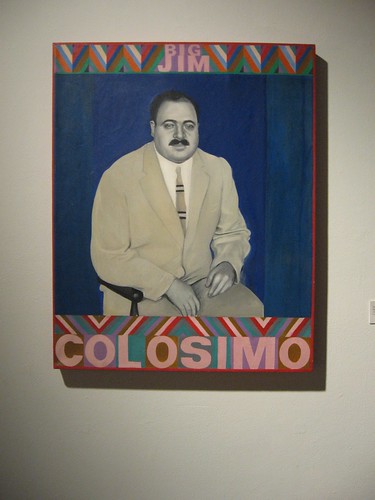 Boty's painting became more experimental. Her work showed an interest inpopular culture early on In 1957 one of her pieces was shown at the Young Contemporaries exhibition alongside work by Robyn Denny, Richard Smith and
Boty's painting became more experimental. Her work showed an interest inpopular culture early on In 1957 one of her pieces was shown at the Young Contemporaries exhibition alongside work by Robyn Denny, Richard Smith and  Bridget Riley.
Bridget Riley.She studied at the School of Stained Glass at the Royal College of Art (1958–61). She had wanted to attend the School of Painting, but was dissuaded from applying as admission rates for women were much lower in that department. Despite the institutionalized sexism at her college,  Boty was one of the stronger students in her class, and in 1960 one of her stained glass works was included in the traveling exhibition Modern Stained Glass organized by the Arts Council. Boty continued to paint on her own in her student flat in west London and in 1959 she had three more works selected for the Young Contemporaries exhibition. During this time she also became friends with other emerging Pop artists, such as David Hockney,
Boty was one of the stronger students in her class, and in 1960 one of her stained glass works was included in the traveling exhibition Modern Stained Glass organized by the Arts Council. Boty continued to paint on her own in her student flat in west London and in 1959 she had three more works selected for the Young Contemporaries exhibition. During this time she also became friends with other emerging Pop artists, such as David Hockney,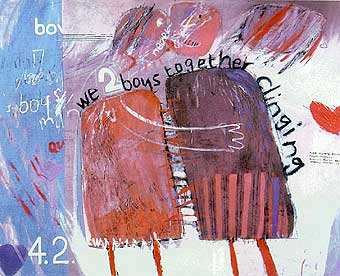 Derek Boshier,
Derek Boshier, Peter Phillips
Peter Phillips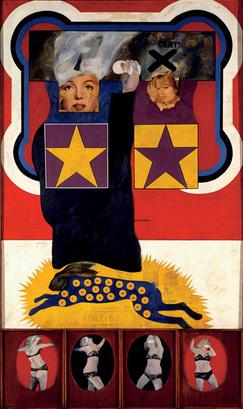 and
and Peter Blake.
Peter Blake.
 Boty was one of the stronger students in her class, and in 1960 one of her stained glass works was included in the traveling exhibition Modern Stained Glass organized by the Arts Council. Boty continued to paint on her own in her student flat in west London and in 1959 she had three more works selected for the Young Contemporaries exhibition. During this time she also became friends with other emerging Pop artists, such as David Hockney,
Boty was one of the stronger students in her class, and in 1960 one of her stained glass works was included in the traveling exhibition Modern Stained Glass organized by the Arts Council. Boty continued to paint on her own in her student flat in west London and in 1959 she had three more works selected for the Young Contemporaries exhibition. During this time she also became friends with other emerging Pop artists, such as David Hockney, Derek Boshier,
Derek Boshier, Peter Phillips
Peter Phillips and
and Peter Blake.
Peter Blake.
While at the Royal College of Art, Boty engaged in a number of extracurricular activities.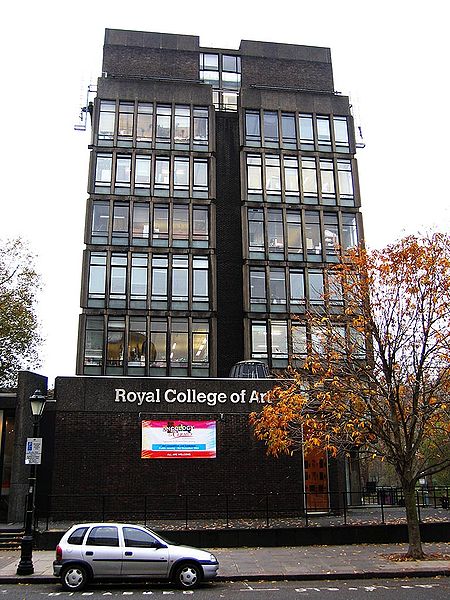 She sang, danced, and acted in somewhat risqué college reviews, published her poetry in an alternative student magazine, and was a knowledgeable presence at the film society where she developed her interest especially in European new wave
She sang, danced, and acted in somewhat risqué college reviews, published her poetry in an alternative student magazine, and was a knowledgeable presence at the film society where she developed her interest especially in European new wave  cinema. She was also an active participant of the Anti-Ugly Action campaign, a group of RCA stained glass, and later architecture, students who protested against new British architecture that they considered offensive and of poor quality.
cinema. She was also an active participant of the Anti-Ugly Action campaign, a group of RCA stained glass, and later architecture, students who protested against new British architecture that they considered offensive and of poor quality.
 She sang, danced, and acted in somewhat risqué college reviews, published her poetry in an alternative student magazine, and was a knowledgeable presence at the film society where she developed her interest especially in European new wave
She sang, danced, and acted in somewhat risqué college reviews, published her poetry in an alternative student magazine, and was a knowledgeable presence at the film society where she developed her interest especially in European new wave  cinema. She was also an active participant of the Anti-Ugly Action campaign, a group of RCA stained glass, and later architecture, students who protested against new British architecture that they considered offensive and of poor quality.
cinema. She was also an active participant of the Anti-Ugly Action campaign, a group of RCA stained glass, and later architecture, students who protested against new British architecture that they considered offensive and of poor quality.
The two years after graduation were perhaps Boty's most productive. She developed a signature Pop style and iconography. Her first group show, "Blake, Boty, Porter, Reeve" was held in November 1961 at A.I.A. gallery in London and was hailed as one of the first British Pop art shows. She exhibited twenty collages, including Is it a bird, is it a plane? and a rose is a rose is a rose, which demonstrated her interest in drawing from both high and low popular culture sources in her art (the first title references the Superman comic, the second quotes American ex-patriate poet Gertrude Stein).
She exhibited twenty collages, including Is it a bird, is it a plane? and a rose is a rose is a rose, which demonstrated her interest in drawing from both high and low popular culture sources in her art (the first title references the Superman comic, the second quotes American ex-patriate poet Gertrude Stein).

The following spring Boty, along with Blake, Boshier, and Phillips, were featured in Ken Russell's BBC film Pop Goes the Easel, which first aired on March 22, 1962. Although the documentary placed Boty at the center of the nascent British Pop art movement, unlike her male peers she did not get an opportunity to speak directly and intelligently about her work during the film.
Boty's appearance on Pop Goes the Easel marked the beginning of her brief acting career. She landed roles in two Armchair Theatre plays for ITV and an episode of the BBC seriesMaigret. Boty also appeared on stage at the Royal Court in Day of the Prince and in Frank Hilton's Afternoon Men at the New Arts Theatre.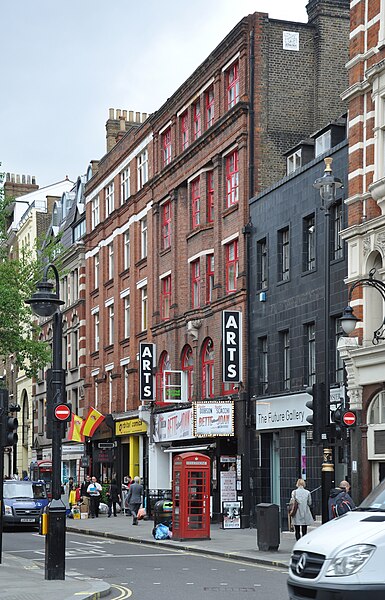 (Boty, a regular on 'swinging 60s' club scene in London, was also a dancer on Top of the Pops and Ready Steady Go!). Although acting was lucrative, it distracted her from painting, which remained her top priority. Yet the men in her life encouraged her to pursue acting, as it was a more conventional career choice for women in the early 1960s. The popular press picked up on her glamorous actress persona, often undermining her legitimacy as an artist by referring to her physical charms. For example, Scene ran a front page article in November 1962 that read, "Actresses often have tiny brains. Painters often have large beards. Imagine a brainy actress who is also a painter and also a blonde and you have PAULINE BOTY."
(Boty, a regular on 'swinging 60s' club scene in London, was also a dancer on Top of the Pops and Ready Steady Go!). Although acting was lucrative, it distracted her from painting, which remained her top priority. Yet the men in her life encouraged her to pursue acting, as it was a more conventional career choice for women in the early 1960s. The popular press picked up on her glamorous actress persona, often undermining her legitimacy as an artist by referring to her physical charms. For example, Scene ran a front page article in November 1962 that read, "Actresses often have tiny brains. Painters often have large beards. Imagine a brainy actress who is also a painter and also a blonde and you have PAULINE BOTY."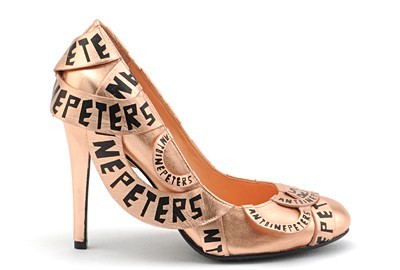
 (Boty, a regular on 'swinging 60s' club scene in London, was also a dancer on Top of the Pops and Ready Steady Go!). Although acting was lucrative, it distracted her from painting, which remained her top priority. Yet the men in her life encouraged her to pursue acting, as it was a more conventional career choice for women in the early 1960s. The popular press picked up on her glamorous actress persona, often undermining her legitimacy as an artist by referring to her physical charms. For example, Scene ran a front page article in November 1962 that read, "Actresses often have tiny brains. Painters often have large beards. Imagine a brainy actress who is also a painter and also a blonde and you have PAULINE BOTY."
(Boty, a regular on 'swinging 60s' club scene in London, was also a dancer on Top of the Pops and Ready Steady Go!). Although acting was lucrative, it distracted her from painting, which remained her top priority. Yet the men in her life encouraged her to pursue acting, as it was a more conventional career choice for women in the early 1960s. The popular press picked up on her glamorous actress persona, often undermining her legitimacy as an artist by referring to her physical charms. For example, Scene ran a front page article in November 1962 that read, "Actresses often have tiny brains. Painters often have large beards. Imagine a brainy actress who is also a painter and also a blonde and you have PAULINE BOTY."
Her unique position as Britain's only female Pop artist gave Boty the chance to redress sexism in her life as well as her art. Her early paintings were sensual and erotic, celebrating female sexuality from a woman's point of view. Her canvases were set against vivid, colorful backgrounds and often included erogenous close-ups of red flowers, symbolic of the female sex. She painted her male idols—Elvis, French actor Jean-Paul Belmondo,
She painted her male idols—Elvis, French actor Jean-Paul Belmondo,
 She painted her male idols—Elvis, French actor Jean-Paul Belmondo,
She painted her male idols—Elvis, French actor Jean-Paul Belmondo,
One short work of art gives one a better idea of Boty's time than Darling does.Looking like an advert for Swinging London, Joe Massot’s 1965 short Reflections on Love mixes pop documentary with scenes devised by writer Derek Marlowe and (apparently) an uncredited, Larry Kramer.
and (apparently) an uncredited, Larry Kramer.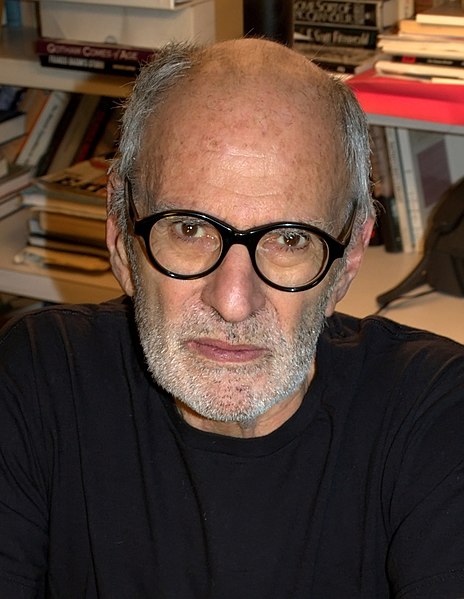 Though everything looks rather beautiful, it is such a terribly straight film, and considering the talent involved, and doesn’t really offer much love for the audience to reflect on. Then, this was the Sixties, when everything was new and exciting, and getting hitched in a registry office was daring and rad. O, how innocent it all seems. Massot went on to direct George Harrison’sWonderwall and later, Led Zeppelin’s concert film The Song Remains the Same. Kramer went on to script Here We Go Round the Mulberry Bush (1967), and Ken Russell’s Women in Love (1969), before writing his novel Faggots in 1978. As for Marlowe, he wrote the classic double-agent spy thriller, A Dandy in Aspic, and followed this up with a series of idiosyncratic and stylish novels (from crime to Voodoo to Lord Byron), which are all shamefully out-of-print, and not even available as e-books - publishers please note.
Though everything looks rather beautiful, it is such a terribly straight film, and considering the talent involved, and doesn’t really offer much love for the audience to reflect on. Then, this was the Sixties, when everything was new and exciting, and getting hitched in a registry office was daring and rad. O, how innocent it all seems. Massot went on to direct George Harrison’sWonderwall and later, Led Zeppelin’s concert film The Song Remains the Same. Kramer went on to script Here We Go Round the Mulberry Bush (1967), and Ken Russell’s Women in Love (1969), before writing his novel Faggots in 1978. As for Marlowe, he wrote the classic double-agent spy thriller, A Dandy in Aspic, and followed this up with a series of idiosyncratic and stylish novels (from crime to Voodoo to Lord Byron), which are all shamefully out-of-print, and not even available as e-books - publishers please note.
 and (apparently) an uncredited, Larry Kramer.
and (apparently) an uncredited, Larry Kramer. Though everything looks rather beautiful, it is such a terribly straight film, and considering the talent involved, and doesn’t really offer much love for the audience to reflect on. Then, this was the Sixties, when everything was new and exciting, and getting hitched in a registry office was daring and rad. O, how innocent it all seems. Massot went on to direct George Harrison’sWonderwall and later, Led Zeppelin’s concert film The Song Remains the Same. Kramer went on to script Here We Go Round the Mulberry Bush (1967), and Ken Russell’s Women in Love (1969), before writing his novel Faggots in 1978. As for Marlowe, he wrote the classic double-agent spy thriller, A Dandy in Aspic, and followed this up with a series of idiosyncratic and stylish novels (from crime to Voodoo to Lord Byron), which are all shamefully out-of-print, and not even available as e-books - publishers please note.
Though everything looks rather beautiful, it is such a terribly straight film, and considering the talent involved, and doesn’t really offer much love for the audience to reflect on. Then, this was the Sixties, when everything was new and exciting, and getting hitched in a registry office was daring and rad. O, how innocent it all seems. Massot went on to direct George Harrison’sWonderwall and later, Led Zeppelin’s concert film The Song Remains the Same. Kramer went on to script Here We Go Round the Mulberry Bush (1967), and Ken Russell’s Women in Love (1969), before writing his novel Faggots in 1978. As for Marlowe, he wrote the classic double-agent spy thriller, A Dandy in Aspic, and followed this up with a series of idiosyncratic and stylish novels (from crime to Voodoo to Lord Byron), which are all shamefully out-of-print, and not even available as e-books - publishers please note.The original version was twenty-one minutes long, and there is the revamped, re-scored (by Kula Shaker), re-edited (12 minutes) re-release from 1999, and still watchable pop-candy.
 —as sex symbols, just as she did actresses Monica Vitti
—as sex symbols, just as she did actresses Monica Vitti  and Marilyn Monroe. Like Andy Warhol, she recycled publicity and press photographs of celebrities in her art. She exhibited in several more group shows before staging her first solo exhibition at Grabowski Gallery in the fall of 1963. The show was a critical success. However, Boty continued to take on
and Marilyn Monroe. Like Andy Warhol, she recycled publicity and press photographs of celebrities in her art. She exhibited in several more group shows before staging her first solo exhibition at Grabowski Gallery in the fall of 1963. The show was a critical success. However, Boty continued to take on  additional acting jobs. She was a presenter on the radio program Public Ear in 1963-64, and in the following year she was typecast yet again in the role of 'the seductive Maria' in a BBC serial.
additional acting jobs. She was a presenter on the radio program Public Ear in 1963-64, and in the following year she was typecast yet again in the role of 'the seductive Maria' in a BBC serial.In June 1963, she married literary agent and television producer Clive Goodwin (1932-77) after a mere ten-day romance.Her marriage disappointed many, including Peter Blake and her married lover, director Philip Saville,  whom she met towards the end of her student days and had worked for.Their affair is said to have inspired the movie Darling (1966)
whom she met towards the end of her student days and had worked for.Their affair is said to have inspired the movie Darling (1966) . Boty and Goodwin's
. Boty and Goodwin's Cromwell Road flat became a central hang-out for many artists, musicians, and writers,
Cromwell Road flat became a central hang-out for many artists, musicians, and writers, including Bob Dylan (whom Boty brought to England) Hockney, Blake.
including Bob Dylan (whom Boty brought to England) Hockney, Blake.
 whom she met towards the end of her student days and had worked for.Their affair is said to have inspired the movie Darling (1966)
whom she met towards the end of her student days and had worked for.Their affair is said to have inspired the movie Darling (1966) . Boty and Goodwin's
. Boty and Goodwin's Cromwell Road flat became a central hang-out for many artists, musicians, and writers,
Cromwell Road flat became a central hang-out for many artists, musicians, and writers,(Pauline had loved America. She wasn't frightened of it, she loved the powerful images at the heart of American culture, and the deep emotions the music and films evoked in her.
Pauline Boty wasn't naive about American power, and she knew those alluring images and sounds could crawl into your brain and shape the way you saw the world, and disguise the underlying exploitation. But she believed that she could possess those images and use her imagination to rework them into something magical, inspiring and liberating.An odd thing has happened in the course of those years. While the bulk of Boty's work - a collection of large painted collages - has been lying, splattered with plaster dust, in an outhouse of her brother's farm in Kent, her image has brightened, regularly polished by memory, nostalgia, a certain habit of mythology. For one thing, the tragedy was compounded 12 years later by the death of her husband, the actor and literary agent Clive Goodwin. He suffered a brain haemorrhage in the foyer of the Beverly Hills Hotel (where he was meeting Warren Beatty to discuss Reds) and died in Los Angeles police custody. They thought he was drunk. There was a court case: the police accepted liability and a large settlement was awarded the daughter, Boty Goodwin. She was brought up by grandparents and guardians (the writer Adrian Mitchell and the actress Celia Mitchell) and studied art in California
The daughter, who refuses to talk about her mother, shares her looks. And Pauline Boty was extremely attractive. 'She was the kind of person people followed,' says Massot. Friends say she resembled Brigitte Bardot - though some, with possessive annoyance, disagree and say Simone Signoret. 'She had that marvellous strawberry ice-cream smile and leonine hair' . . . 'There was this great laugh - her face would completely distort, her top lip would spread right across' . . . 'She was very voluptuous . . . quite a big girl, very tall, with lovely skin and hair and teeth - a lovely-shaped head'. And, according to Brian Newman, a fellow student, she had 'something of Marilyn Monroe's ability to engender sympathy'.
The daughter, who refuses to talk about her mother, shares her looks. And Pauline Boty was extremely attractive. 'She was the kind of person people followed,' says Massot. Friends say she resembled Brigitte Bardot - though some, with possessive annoyance, disagree and say Simone Signoret. 'She had that marvellous strawberry ice-cream smile and leonine hair' . . . 'There was this great laugh - her face would completely distort, her top lip would spread right across' . . . 'She was very voluptuous . . . quite a big girl, very tall, with lovely skin and hair and teeth - a lovely-shaped head'. And, according to Brian Newman, a fellow student, she had 'something of Marilyn Monroe's ability to engender sympathy'.
Here is one of her paintings that expresses that confidence. It's called The Only Blonde in the World. She painted it in 1963.)

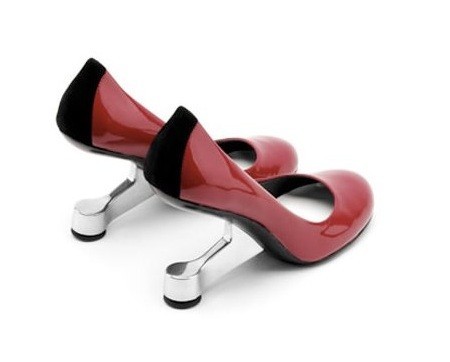

Her husband Goodwin, who would later co-found the radical journal Black Dwarf, is said to have encouraged Boty to include political content in her paintings. Her paintings did become more overtly critical over time. Countdown to Violence depicts a number of harrowing current events,
Her paintings did become more overtly critical over time. Countdown to Violence depicts a number of harrowing current events, including the assassination of President John F. Kennedy, the Vietnam War, and theBirmingham race riots. Cuba Si (1963) references the Cuban revolution.
including the assassination of President John F. Kennedy, the Vietnam War, and theBirmingham race riots. Cuba Si (1963) references the Cuban revolution. The collaged painting It's a Man's World I (1964) juxtaposes images of The Beatles, Albert Einstein, Lenin,Muhammed Ali, Marcel Proust,
The collaged painting It's a Man's World I (1964) juxtaposes images of The Beatles, Albert Einstein, Lenin,Muhammed Ali, Marcel Proust, and other men, suggesting that despite male domination in Western society, the notion of masculinity itself might be fracturing.
and other men, suggesting that despite male domination in Western society, the notion of masculinity itself might be fracturing.  Boty continued her analysis of male privilege with It's a Man's World II (1965–66) in which she redisplays female nudes from fine art and soft-core pornographic sources, calling attention to men's easy access to sexualized female bodies.
Boty continued her analysis of male privilege with It's a Man's World II (1965–66) in which she redisplays female nudes from fine art and soft-core pornographic sources, calling attention to men's easy access to sexualized female bodies.
 Her paintings did become more overtly critical over time. Countdown to Violence depicts a number of harrowing current events,
Her paintings did become more overtly critical over time. Countdown to Violence depicts a number of harrowing current events, including the assassination of President John F. Kennedy, the Vietnam War, and theBirmingham race riots. Cuba Si (1963) references the Cuban revolution.
including the assassination of President John F. Kennedy, the Vietnam War, and theBirmingham race riots. Cuba Si (1963) references the Cuban revolution. The collaged painting It's a Man's World I (1964) juxtaposes images of The Beatles, Albert Einstein, Lenin,Muhammed Ali, Marcel Proust,
The collaged painting It's a Man's World I (1964) juxtaposes images of The Beatles, Albert Einstein, Lenin,Muhammed Ali, Marcel Proust, and other men, suggesting that despite male domination in Western society, the notion of masculinity itself might be fracturing.
and other men, suggesting that despite male domination in Western society, the notion of masculinity itself might be fracturing.  Boty continued her analysis of male privilege with It's a Man's World II (1965–66) in which she redisplays female nudes from fine art and soft-core pornographic sources, calling attention to men's easy access to sexualized female bodies.
Boty continued her analysis of male privilege with It's a Man's World II (1965–66) in which she redisplays female nudes from fine art and soft-core pornographic sources, calling attention to men's easy access to sexualized female bodies.
In She refused to have an abortion in order to receive chemotherapy treatment that would have harmed the fetus. Instead Boty smoked marijuana to ease the pain of her terminal condition during her pregnancy. She continued to entertain her friends and even sketched The Rolling Stones  during her illness. Her daughter, Boty Goodwin, was born in February 1966. Her last known painting,BUM, was commissioned by Kenneth Tynan for Oh, Calcutta! and was completed in 1966. Boty died at the Royal Marsden Hospital on 1 July that year. She was 28 years old, not much younger than when her daughter, Boty Goodwin, died of a heroin overdose in 1995 while living in Los
during her illness. Her daughter, Boty Goodwin, was born in February 1966. Her last known painting,BUM, was commissioned by Kenneth Tynan for Oh, Calcutta! and was completed in 1966. Boty died at the Royal Marsden Hospital on 1 July that year. She was 28 years old, not much younger than when her daughter, Boty Goodwin, died of a heroin overdose in 1995 while living in Los
 during her illness. Her daughter, Boty Goodwin, was born in February 1966. Her last known painting,BUM, was commissioned by Kenneth Tynan for Oh, Calcutta! and was completed in 1966. Boty died at the Royal Marsden Hospital on 1 July that year. She was 28 years old, not much younger than when her daughter, Boty Goodwin, died of a heroin overdose in 1995 while living in Los
during her illness. Her daughter, Boty Goodwin, was born in February 1966. Her last known painting,BUM, was commissioned by Kenneth Tynan for Oh, Calcutta! and was completed in 1966. Boty died at the Royal Marsden Hospital on 1 July that year. She was 28 years old, not much younger than when her daughter, Boty Goodwin, died of a heroin overdose in 1995 while living in Los
Boty, like many of her contemporaries, used images of Monroe in her work. It's ironic that she should herself have been turned into an icon - a different icon for different people. For the artist Peter Blake she was the first woman in London to wear men's 501s ('I used to say, 'Pauline, your flies are undone.' It was a reasonably funny thing to say to a woman in 1961'). For the usually laconic impresario Michael White, she was 'unique in every department, remarkably ahead of her time,' but for Caroline Coon, the feminist artist who met her only once, she was a woman in agony, the victim of male oppression Angeles.
Angeles.
 Angeles.
Angeles.- 1965 "The Edgar Wallace Mystery Theatre" (Episode: Strangler's Web) ... Nell Pretty
- 1965 BBC TV, The Londoners - A Day Out for Lucy ... Patsy
- 1965 "Contract to Kill" (BBC TV mini-series) ... the seductive Maria Galen
- 1965 "The Day of Ragnarok"
- 1964 Ken Russell's Béla Bartók (BBC Monitor Series) .... Prostitute
- 1964 BBC, Short Circuit-The Park ... Pauline
- 1964 "Espionage" (Episode: The Frantick Rebel) ... Mistress Fleay
- 1963 "Ready, Steady, Go!" ... Dancer
- 1963 "Don't Say a Word" (game show) ... herself
- 1963 BBC, Maigret: Peter the Lett ... Josie
- 1962 BBC, The Face They See ... Rona
- 1962 ITV Armchair Theatre (Episodes: North City Traffic Straight Ahead and North by North West) ... Anna
- 1962 Ken Russell's Pop Goes the Easel (BBC Monitor Series) ... Herself
After her death, Pauline Boty's paintings were stashed away in a barn on her brother's farm, and she was largely forgotten over the next thirty years. Her work was rediscovered in the 1990s, renewing interest in her radical and significant contribution to Pop art gaining her inclusion in several group exhibitions and a major solo retrospective.
In 1964 the BBC made a film about the pop movement. It was called Pop Goes the Easel and was directed by Ken Russell.It focussed on four artists but the two stars of the film were Pauline Boty and her best friend Derek Boshier.
Boshier brilliantly describes how popular images of American power seduce the mind - they start to "infiltrate you at the breakfast table". But one shouldn't be frightened because it is possible to possess those images in turn.
Then there is Pauline Boty - her bit begins with a wonderful piece of film-making - where she is the girl running away.
Ken Russell's production notes for the film say that "the authoritative woman in the wheelchair, should be someone representing authority, hideously formal". While the three girls around her "need to look as though they represent an institution."
And Pauline should play "herself - an art student resenting authority"
The first shots in the film are of all four artists together - they were all friends - the other two are Peter Blake and Peter Phillips. It is beautifully shot, and the song is Goodbye Cruel World by James Darren. 

She openly expressed her resentment for the sexism she’d encountered in her life and celebrated her femininity and the almighty s-e-x. Most of the pieces include vibrant colors or chose red flowers, symbols for femininity, as the focal point. Her greatest paintings are teenybopper-esque representations of the sex symbols of her time. Elvis French, Jean-Paul Belmondo, Monica Vitti, and Marilyn Monroe and these represent where the sixties heart was really at , I say that not as a criticism but a continuance of those sixties dreams when youth was first invented-maybe .Where did the Sixties go? Well it just became commercialised and people were seduced by it and anyway it was always commercial in the main. If the political angle had been properly aimed at the workers then maybe society could have been changed but most of the currents and movements in the 60's were not socialist but bourgeois attempts at becoming and overcoming their dreams of capitalism with outbursts. The end result of is like one of Herbert Marcuse's theories.
He had said the capitalist power works by possessing and manipulating the desires inside your own mind. But no-one ever explained how you distinguished between the two kinds of dreams inside your head - the ones that were planted there by evil capitalist fantasy-machines, and the genuine dreams of a new and better future. And if your dreams of a better future failed, and the world didn't change - then maybe they too were just part of the manipulation?
He had said the capitalist power works by possessing and manipulating the desires inside your own mind. But no-one ever explained how you distinguished between the two kinds of dreams inside your head - the ones that were planted there by evil capitalist fantasy-machines, and the genuine dreams of a new and better future. And if your dreams of a better future failed, and the world didn't change - then maybe they too were just part of the manipulation?

Interesting article on a truly creative and beautiful woman.
ReplyDeletecheers
Delete